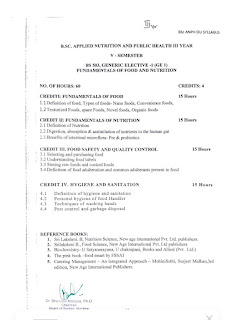Sunday, 15 December 2024
Saturday, 23 November 2024
Tuesday, 17 September 2024
Saturday, 30 March 2024
Photosynthetic Pigments
PhotosyntheticPhotosynthetic Pigments
Photosynthetic pigments are the
most important coloured components of the chloroplast lamellae. These pigments
are molecules that strongly absorb visible light. They interact with sunlight
to alter the wavelengths that are either reflected or transmitted by the plant tissue.
These pigments are also found in cyanobacteria and algae.The chloroplasts
contain pigments like chlorophylls,carotenoids and phycobillins.
The major groups of
photosynthetic pigments are:
- Chlorophyll
- Carotenoids
- Phycobilins
- Flavonoids
Chlorophyll
The most widespread pigment in
photosynthetic plants is chlorophyll. They are cyclic tetrapyrrole pigments
chelated with magnesium. They share structural features with the haem and bile
pigments of animals. These chlorophyll pigments can be found in fruits, flowers
as well as leaves.
Chlorophyll a and chlorophyll b
are the major types of chlorophylls found in plants. The former is a blue-green
pigment and the latter is a yellow-green pigment. They give their
characteristic green colour due to the strong absorbance of red and blue light.
Type of Chlorophyll
Chlorophyll a
This pigment is found in all higher plants. It is the most vital pigment
used in photosynthesis. Some algae, cyanobacteria and
anaerobic phototrophs also show the presence of chlorophyll a. It has a strong
rate of absorption. It absorbs violet-blue as well as orange-red light and
reflects blue-green light.
Chlorophyll a is present universally in all plant groups except green
and purple bacteria.it is a tetrapyrrole having a porphyrin head with Mg2+
in the centre forming a complex. The head part is hydrophilic. Attached to the
head is a long hydrophobic chain of terpene alcohol called phytol which forms
the tail part of chlorophyll
Chlorophyll – Chemical Formula –
C₅₅ H₇₂ O₅ N₄ Mg
Chlorophyll b
This type of chlorophyll is seen in green algae and plants. It is an
accessory pigment that aids chlorophyll a. This pigment usually absorbs the
orange-red light and reflects a yellow-green colour. The chlorin ring of this
chlorophyll has a CHO. Whereas, the chlorin ring of Chlorophyll-a contains CH3
Chlorophyll a Chlorophyll b
Chlorophyll c
This pigment is primarily seen in marine algae. Brown algae, Diatoms and
Dinoflagellates show the presence of chlorophyll c. It is an unusual
chlorophyll pigment that has a porphyrin ring. This can be further classified
into chlorophyll c1, c2 and c3. The chemical composition and the absorption rate differ in each
sub-type.
Chlorophyll d
Chlorophyll d is present only in red algae and cyanobacteria. These
organisms live in deep water, and thus use red light for photosynthesis.
Chlorophyll e
This is a rare pigment that is found in some golden algae. Chlorophyll e
has been identified from the Xanthophytes (yellow-green algae).
Carotenoids
Carotenoids are also associated
with the process of photosynthesis. Additionally, they give a bright colour to
the fruits and flowers. They are terpenoid pigments present in all
photosynthetic plants and they also occur in photosynthetic bacteria such
as Rhodobacter and Erwinia. Carotenoids are
orange, red and yellow pigments that usually occur in the roots, tubers, leaves,
fruits, seeds and flowers.
Carotenoids are found essentially
in all green plants.while chlorophylls absorb srongly in the red and the blue
regions,carotenoids absorb mostly in the blue as well as in the green regions
of the spectrum.that’s why leaves reflect green and yellow colour. Carotenoid
function as accessory pigments for photosynthesis.They are also reuired for
protecting photosynthetic pigments from the destructive photo oxidation that
occurs in the presence of light and oxygen. The carotenes contain carbons and
hydrogen while xanthophyll contains oxygen besides Carbon and Hydrogen.
Phycobilins
It is a light-capturing bile
pigment found in the Chloroplast of red algae and
cyanobacteria. They have chromatophores that are primarily responsible for
their colour. These are unique pigments as they are bonded to water-soluble
phycobiliproteins which pass sunlight to chlorophyll and thus help in the
process of photosynthesis.
Tuesday, 12 March 2024
Dept.of Botany, GDC W Hussainialam
Semester-IV
Question Bank for Internal Examination
1.
Karyokinesis
differs from cytokinesis because it involves
A.
Division of cytoplasm B. Division of the Nucleus C. Division of cell D. B andC
2.
Meiosis
involves two divisions : These divisions are
A.One reduction division and one mitotic
division B. One nuclear, and one
somatic division
C.
One equatorial, and one nuclear division D. One reduction, and one cell division
3.
The
term plasma lemma was coined by
A. Nageli and crammer B.
Nageli C. Plowe D.
Frey – Wyssling
4.
Fluid-
Mosaic model was given by
A. Singer and Nicholson B. Robert Brown C. Watson and crick D. Beadle and Tatum
5.
Plasma
membrane is made up of
A. Lipids B. Proteins C. Lipoproteins D.
Cellulose
6.
The
term cell membrane was coined by
A. Plowe B. Robert
son C. Overton D. Nageli
and cramer
7.
The
main difference between the prokaryotic cell and the eukaryotic cell is that in
the prokaryotic cell, there is no
A. Internal membrane system B.
cell wall C. Genetic
system D. Nucleus
with a nuclear membrane
8.
The
Unit of Cellulose is
A. Glucose
B. Fructose C. Mannose 4. Galactose
9.
The
Plant cells differ from animal cell in
A.
having chlorophyll B. Cellulose wall C. Bigger in size D. None of the above
10. A prokaryotic cell lacks
A. Nuclear membrane B.
Nucleolus C. Membrane bound cell
organelles D. All of the above
11. Chromosome is composed of
A. DNA
B. Protein C. RNA D. DNA,
RNA and Protein
12. The nucleolus is chemically composed of
A.
RNA, DNA & Protein B. RNA and DNA only C.
DNA only D. RNA only
13. Mitochondria are absent in
A.
Yeast B. Fungi C. Green algae D. Bacteria
14. The main function of mitochondria is
A. Excretion B. Respiration C. Osmoregulation D. Secretion
15. The enzymes of krebs cycle occurring in the mitochondrian
are located.
A. On the outer
unit membrane B. In the
perimitochondrial space
C. On the inner unit
membrane D. In the
mitochondrial matrix
16. Quantosomes are found in
A.
Mitochondria B. Nucleus C . chloroplast D. Lysosomes
17. In higher plants chloroplast, Pigments are arranged in
A.
Matrix B. Grana of Chloroplast C.
Outer membrane of chloroplast D. Inner
membrane of chloroplast
18. Heterozygote have
A
. only dominant gene B. Only
recessive gene C. Both of these D.None of these
19. Assume cross between red and white flowered plants
which produce pink
A. This is an example of dominance B.Ths. is due to co-dominance
C. This is due
to segregation D.
This is due to incomplete
dominance
20. Back-cross is
A. Cross-between parents
B. Cross between Plants of F, generation
C. Cross between progeny and parents D. Cross between progeny and Progeny
21. Allele is called
A. a pair of chromosome
B. a pair of contrasting
character. C. a pair of sex chromosome
D. None
of these
22. Crossing over occurs in
A.
Meiosis B. Mitosis C. Amitosis D. All of these
23. The Co-existence of two or more genes in the same
chromosomes is termed as
A.
Mutation B. Linkage C. Crossing over D. Polyploidy
24. The three important laws of heredity pro- posed by
mendal related to
A. Gene linkage, dominance and segregation B. Only dominance
C. Only segregation D. Linkage
25. Mendelian recombinations are due to
A.
Linkage B. Dominance C. Independent assortment of genes
D.None
26. How many gametes may by Produced by an organism with
the genotype RrYy
A.
6 B. 4 C.
2 D. 8
27. The cross of F1 hybrid with its recessive
parent is called
A.
Back cross B. Test Cross C. Incomplete cross D. low cross
28. When a gene exists in more than one form are called
A.
Alleles B. Test cross C. Linkage D.
Back cross
29. Which year was Rediscovery of Mendal laws of
inheritance
A.1900
B. 1800 C. 1600 D. 2000
30. What is the ratio in F₂ generation of monohybrid cross
A. 4:1 B. 1:2:1 C. 3:3 D. 2:2
31. A pure white flowered recessive plant crossed with a
dominant pure red flowered plant what shows the first generation
A.
all red flowered plants B.Pink flowers C.White flowers D. Red and white
32. To produce 100 pollen grains, how many microspore
mother cells
A.
25 B. 30 C. 15 D.40
33. Exchange of chromosome segments between maternal and
paternal chromatid during meiosis is called
A. Test cross B.Crossing over C.Linkage D.Back Cross
34. During meiosis reduction of chromosomes numbers into
half takes place in which phase.
A.
Metaphase-I B. Anaphase-I C. Prophase-I D. All of these
35. In meiosis crossing over takes place in which phase
A. Zygotene B.
Pachytene C. Diplotene D. Leptotene
36. Which phase required to longest duration in
mitosis
A.
G1 Phase B. S Phase C.
G2 Phase D. All of these
37. What type of shape appear in the metacentric
chromosomes
A.
L- shaped B.J-shaped C. V-shaped D.
i-Shaped
38. Separation of homologous chromosomes during meiosis
occurs at which phase
A
.Metaphase-I B. Telophase-I C. Anaphase-I D.
Prophase-I
39. What plant material is best suited for studying
A. Root tips B.
Stem C. Leaf D.All of these
40. The cell organelle associated with photorespiration
A.
Mitochandria B. Peroxisome C. Golgi
body D. Glyoxysome
41. Who coined the term nucleus
a)
Robert Brown b) Robert Hook c)
Schleiden d) Schwan
42. Mitosis is also known as
a)
Random division b) equational division c) reduction
division d) unequal division
43. The percentage of lipids in plasma membrane
A. 60% B. 90% C. 80% D. 50%
44. Trilamellar model was proposed by
A. Robert brown
B.Robert hook C. Danielli &Dayson D. Mendel
45. Number of chromosomes in human beings
A.
45 B. 47 C. 46 D. 23
46. Modem cell theory was proposed by Virchow
47. The term cell membrane was coined by Nagelu and cramer
48. Fluid mosaic model was given by Singer and Nicolson
49. The two main components of plasmamembrane- Lipds and Proteins
50. The main function of plasma membrane is to- Regulate the flow of materials into and
outside the cell
51. Plasma membrane is made up of –Lipoprotein
52. `The chromosome ends are known as –Telomere
53. The Word chromosome was given by-Waldeyer
54. During mitosis the nuclear membrane disappear at which
stage –Late prophase
55. Law of segregation was proposed by –Gregor Mendal
56. The intermediate type of inheritance in F1 generation
is called as- Incomplete dominance
57. If the centromere is terminal the chromosome is
called-Telocentric
58. The ratio of phenotypes in F 2 generation in dihybrid
cross is _9: 3:3:1
59. Mobile elements of Chromosomes proposed by –Watson and Crick
Short questions
1.
Mention
difference between DNA and RNA
2.
Draw
diagram of Chromosome
3.
Test
Cross
4.
Law
of segregation
5.
Lampbrush
chromosomes
6.
Pachytene
7.
G1-Phase
Internal
Assessment Model Paper
Section –A
I.
Multiple Choice Questions 10X ½=5
1. to 10
Section-B
II.
Fill in the Blanks 10 X ½=5
1. to 10
Section-C
III.
Answer all Short questions 5X1=5
1.
2.
3.
4.
5.


































